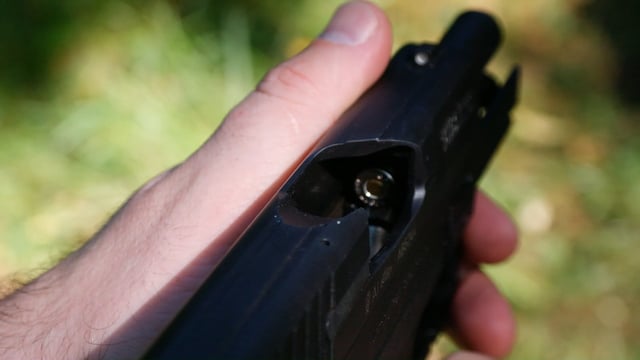This article explores the various firearm conditions used to declare firearm readiness and ensure safety. It details each condition, emphasizing its importance for single-action, double-action, and striker-fire pistols.
This comprehensive firearm conditions guide is here to help you have an understanding of the different firearm carry conditions, which is crucial for ensuring the safe handling and readiness of your firearm. These firearm conditions help shooters and firearm operators quickly and clearly communicate the status of their firearms, whether at a range or in everyday scenarios. In this detailed guide, we’ll explore the various firearm conditions, explain their importance, and discuss how they apply to different types of pistols, including Single-Action/Double-Action (SA/DA) and striker-fired models.
Table of Contents
Condition 0, Condition 1, Condition 2, Condition 3, Condition 4

Condition 0: Fully Ready to Fire
Condition 0 means the firearm is ready to fire immediately. It indicates that the magazine is inserted, a round is chambered, and the safety is off. For Single-Action/Double-Action pistols, the hammer is back. This condition is typically used by those who need to be ready to fire at a moment’s notice, such as law enforcement officers or in self-defense situations.
For everyday concealed carry, Condition 0 might be chosen by experienced carriers who are confident in their ability to handle their firearm safely. However, it’s important to note that this condition requires the highest level of caution and respect, as the firearm is fully ready to discharge.
Condition 1: Loaded with Safety Engaged
In Condition 1, the magazine is inserted, a round is in the chamber, but the safety is engaged. For SA/DA pistols, the hammer is back. This condition is often referred to as “cocked and locked” and is commonly used by carriers of 1911-style pistols.
Condition 1 allows for quick access to a ready firearm while maintaining an additional safety measure. It’s a popular choice among those who want their firearm to be prepared to fire with a minimal delay, but with the added safety of an engaged manual safety.
Condition 2: Loaded, Safety Off, Hammer Forward
Condition 2 applies primarily to SA/DA pistols. In this condition, the magazine is inserted, a round is in the chamber, and the hammer is forward. For revolvers, this means rounds are inserted into the cylinder, the cylinder is locked into place, and the hammer is forward.
This condition is somewhat of a middle ground. It’s ready to fire, but not as immediately as Conditions 0 or 1, since the hammer must be cocked first. Many concealed carriers who use SA/DA pistols prefer this condition for the balance it offers between readiness and safety.
Condition 3: Magazine Inserted, Chamber Empty
In Condition 3, the magazine is inserted, but there is no round in the chamber. For SA/DA pistols, the hammer is forward. This condition is often used by those who prefer an extra layer of safety, ensuring that a round must be chambered before the firearm can be fired.
Many concealed carriers favor Condition 3 for the added peace of mind, knowing that their firearm cannot discharge without racking the slide. This can be a particularly good choice for those who may be newer to carrying or who prioritize safety above all, although it is not the recommended choice for concealed carry.
Condition 4: Completely Safe
Condition 4 is the safest state for a firearm. It means that the magazine is removed, and there is no round in the chamber. For SA/DA pistols and revolvers, the hammer is forward, and the cylinder is clear of all rounds.
This condition is ideal for transporting firearms in a range environment or when handing off a firearm to another person. Ensuring a firearm is in Condition 4 significantly reduces the risk of a negligent discharge and allows for quick and easy inspection by range safety officers or others.
Practical Applications and Considerations for Firearm Conditions
Understanding and utilizing these firearm carry conditions is not only about safety but also about practical application and readiness. While these conditions are most commonly referenced in range environments, they also have implications for everyday concealed carry and home defense.
For instance, many concealed carriers choose Condition 3 due to its balance of safety and readiness. On the other hand, those carrying striker-fired pistols, like the Glock 19, often opt for Condition 0, trusting their holster and training to prevent negligent discharge.
Striker-Fired Pistols
For striker-fired pistols like the Glock 19X, Conditions 0 and 3 are most relevant. Condition 0 is often used by experienced carriers who are confident in their ability to handle their firearm safely, while Condition 3 provides an added layer of safety by requiring the slide to be racked before firing.
Single-Action/Double-Action Pistols
SA/DA pistols offer more flexibility with Conditions 1 and 2. Condition 1, with the hammer back and safety on, is preferred by those who need quick access. Condition 2, with the hammer forward, offers a secure option for home defense or when an additional safety measure is desired.
Revolvers
For revolvers, Conditions 2 and 4 are most applicable. Condition 2 means that the revolver is loaded and ready to fire but with the hammer forward, adding a deliberate step before firing. Condition 4 ensures that the revolver is completely safe and clear, ideal for transport and inspection.
Final Thoughts
No matter which condition you choose to carry your firearm in, the key factors are familiarity and competency. Knowing your firearm’s mechanics and being confident in your ability to handle it safely is paramount. Regular training and practice are essential to ensure that you can operate your firearm effectively and responsibly.
Understanding and applying the different firearm conditions is crucial for anyone who handles firearms, whether for personal defense, law enforcement, or recreational shooting. Each condition represents a specific level of readiness and safety, allowing for clear communication and effective management of firearms in various environments.
Emphasis on Safety
Safety is paramount in all firearm-related activities. Knowing the condition of your firearm at all times can prevent accidents and ensure that the firearm is only ready to fire when intended. This knowledge helps mitigate risks associated with negligent discharges, which can have severe consequences.
For instance, when transporting a firearm to and from a shooting range, placing it in Condition 4 (no magazine inserted, no round in the chamber) is a widely accepted best practice. This ensures the firearm is safe to handle, inspect, and transport, significantly reducing the likelihood of an accidental discharge.
Importance of Regular Training
Regular training and practice are essential for maintaining proficiency and confidence in handling your firearm. This training should include familiarization with all conditions and the ability to transition between them quickly and safely. Practicing these transitions in controlled environments, such as a shooting range, helps build muscle memory and situational awareness.

Consider incorporating drills that require you to move between different conditions. For example, practice moving from Condition 4 to Condition 1 and back, ensuring you can do so efficiently while maintaining safety. This can be particularly useful in high-stress situations where quick decision-making is required.
Context-Specific Readiness
Choosing the appropriate condition for your firearm depends largely on the context in which it is being used. For concealed carriers, the choice between Condition 0, 1, 2, or 3 will depend on factors such as comfort level, training, and the specific firearm being carried. For home defense, the balance between readiness and safety is crucial, often making Condition 2 an ideal choice.
For law enforcement officers, the need for immediate response capabilities might dictate carrying in Condition 0, but this comes with a heightened responsibility to prevent negligent discharges. Officers undergo extensive training to ensure they can handle this level of readiness safely.
Enhanced Situational Awareness
Being aware of your firearm condition at all times enhances your overall situational awareness. This awareness is a critical component of responsible firearm ownership. It involves not only understanding the current state of your firearm but also being prepared to adjust that state based on the environment and the potential threats you might face.
For example, if you are in a public setting where carrying in Condition 3 provides an added level of safety, being aware of this and knowing how to quickly move to a more ready state if needed is essential. This adaptability can make a significant difference in ensuring both your safety and the safety of those around you.
Communication Among Firearm Users
Clear communication among firearm users is another benefit of understanding firearm conditions. Whether you are at a range, in a training session, or in a real-life scenario, being able to quickly convey the condition of your firearm to others can enhance safety and coordination. This is particularly important in group settings where multiple firearms are present.
For instance, during a range session, if the range safety officer calls for all firearms to be in Condition 4, everyone knowing exactly what that means ensures that all firearms are safe for handling and inspection. This common understanding reduces the risk of accidents and creates a safer environment for all participants.
Adapting to Technological Advances
As firearm technology evolves, new features and mechanisms might be introduced that affect how we think about and implement firearm conditions. Staying informed about these advancements and how they impact safety and readiness is important for all firearm owners. Manufacturers often provide updated guidance and training materials to help users adapt to new technologies.
Conclusion
Mastering the different firearm conditions is a fundamental aspect of responsible firearm ownership and usage. Whether you are a recreational shooter, a concealed carrier, or a law enforcement officer, understanding these conditions helps ensure that you can handle your firearm safely and effectively.
Regular training, context-specific readiness, and clear communication are key components of this mastery. By continually honing your skills and staying informed about technological advancements, you can enhance your safety and the safety of those around you.
Safety Tip: Always perform a visual and physical inspection to confirm your firearm’s condition before handling or passing it to another person. This practice helps prevent negligent discharges and ensures everyone’s safety.








![[VIDEO] Squib Loads Aren’t Funny, But Rob Pincus Made This One Hilarious](https://imagedelivery.net/sbm_lYeJbALkepJgtmRD5w/concealednation.org/2018/07/ScreenHunter_1469-Jul.-22-17.20.jpg/w=728,h=381)





